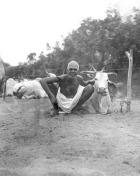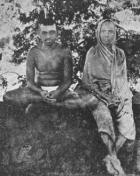Ramana Maharshi's Mother Enlightenment

There were other ways also in which the mother (Ramana Maharshi Mother) was made to realize that he who had been born her son was a Divine Incarnation. Once as she sat before him he disappeared and she saw instead a lingam (column) of pure light. Thinking this to mean that he had discarded his human form, she burst into tears,but soon the lingam vanished and he reappeared as before. On another occasion she saw him garlanded and surrounded with serpents like the conventional representations of Siva.
She cried to him: “Send them away! I am frightened of them!” After this she begged him to appear to her henceforth only in his human form. The purpose of the visions had been served; she had realized that the form she knew and loved as her son was as illusory as any other he might assume. In 1920 the health of the mother began to fail. She was able to work less in the service of the Ashram and was obliged to rest more. During her illness Sri Bhagavan attended on her constantly, often sitting up at night with her.
In silence and meditation her understanding matured. The end came in 1922 on the festival of Bahula Navami, which fell that year on May 19th. Sri Bhagavan and a few others waited on her the whole day without eating. About sunset a meal was prepared and Sri Bhagavan asked the others to go and eat, but he himself did not. In the evening a group of devotees sat chanting the Vedas beside her while others invoked the name of Ram.
For more than two hours she lay there, her chest heaving and her breath coming in loud gasps, and all this while Sri Bhagavan sat beside her, his right hand on her heart and his left on her head. This time there was no question of prolonging life but only of quieting the mind so that death could be Mahasamadhi, absorption in the Self. At eight o’clock in the evening she was finally released from the body. Sri Bhagavan immediately rose, quite cheerful. “Now we can eat,” he said; “come along, there is no pollution.”
There was deep meaning in this. A Hindu death entails ritualistic pollution calling for purificatory rites, but this had not been a death but a reabsorption. There was no disembodied soul but perfect Union with the Self and therefore no purificatory rites were needed. Some days later Sri Bhagavan confirmed this: when someone referred to the passing away of the mother he corrected him curtly, “She did not pass away, she was absorbed.”
Describing the process afterwards, he said: “Innate tendencies and the subtle memory of past experiences leading to future possibilities became very active. Scene after scene rolled before her in the subtle consciousness, the outer senses having already gone. The soul was passing through a series of experiences, thus avoiding the need for rebirth and making possible Union with the Spirit. The soul was at last disrobed of the subtle sheaths before it reached the final Destination, the Supreme Peace of Liberation from which there is no return to ignorance.”
Potent as was the aid given by Sri Bhagavan, it was the saintliness of Alagammal, her previous renunciation of pride and attachment, that enabled her to benefit by it. He said later: “Yes, in her case it was a success; on a previous occasion I did the same for Palaniswami when the end was approaching, but it was a failure. He opened his eyes and passed away.” He added, however, that it was not a complete failure in the case of Palaniswami, for although the ego was not reabsorbed in the Self, the manner of its going was such as to indicate a good rebirth.
Often when devotees suffered bereavement Sri Bhagavan reminded them that it is only the body that dies and only the I-am-the-body illusion that makes death seem a tragedy. Now, at the time of his own bereavement, he showed no grief whatever. The whole night he and the devotees sat up singing devotional songs. This indifference to his mother’s physical death is the real commentary on his prayer at the time of her previous sickness. The question arose of the disposal of the body.
There was the testimony of Bhagavan himself that she had been absorbed into the Self and not remained to be reborn to the illusion of ego, but some doubt was felt whether the body of a woman Saint should be given burial instead of being cremated. Then it was recalled that in 1917 this very point had formed part of a series of questions put to Sri Bhagavan by Ganapati Sastri and his party and that he had answered affirmatively. “Since Jnana (Knowledge) and Mukti (Deliverance) do not differ with the difference of sex, the body of a woman Saint also need not be burnt. Her body also is the abode of God.”
In the case of her leaving the Ashram as in that of her joining it, none presumed to ask Sri Bhagavan himself for a decision, nor did he pronounce one. It seems not to have occurred to them that the answer had been given in his prayer of 1914: “Enfold my Mother in Thy Light and make her One with Thee! What need then for cremation?”
Sri Bhagavan stood silently looking on without participating. The body of the mother was interred at the foot of the hill at the southern point, between the Palitirtham Tank and the Dakshinamurti Mantapam (shrine).
Relatives and friends arrived for the ceremony and large crowds came from the town. Sacred ashes, camphor, incense, were thrown into the pit around the body before it was filled up. A stone tomb was constructed and on it was installed a sacred lingam brought from Benares. Later a temple was raised on the spot, finally completed in 1949 and known as Matrubhuteswara Temple, the Temple of God Manifested as the Mother.
As the coming of the mother had marked an epoch in Ashram life, so also did her departure. Instead of being checked, the development increased. There were devotees who felt that, as Shakti or Creative Energy, her presence was more potent now than before. On one occasion Sri Bhagavan said: “Where has she gone? She is here.”
-From Book "Ramana Maharshi and Path of self knowledge"



 https://oshofriends.com/on_maharshi/27977
https://oshofriends.com/on_maharshi/27977

